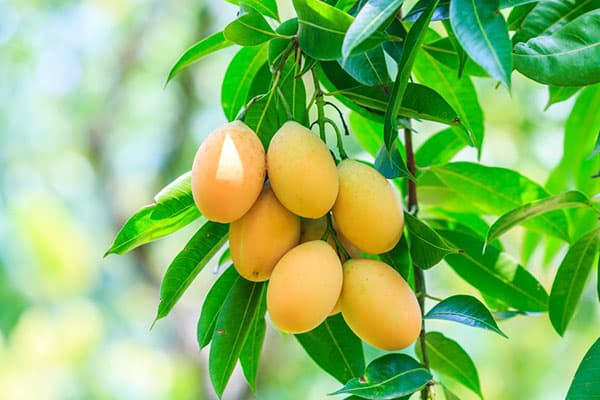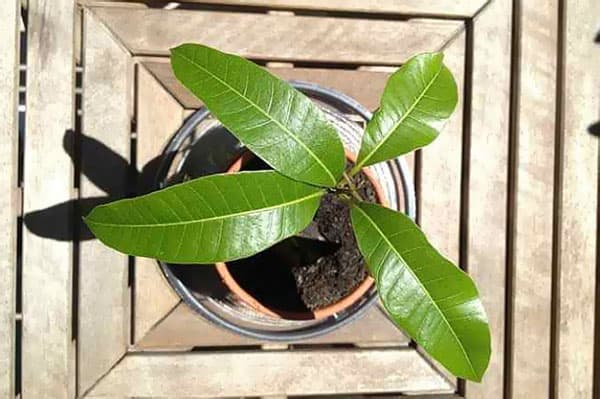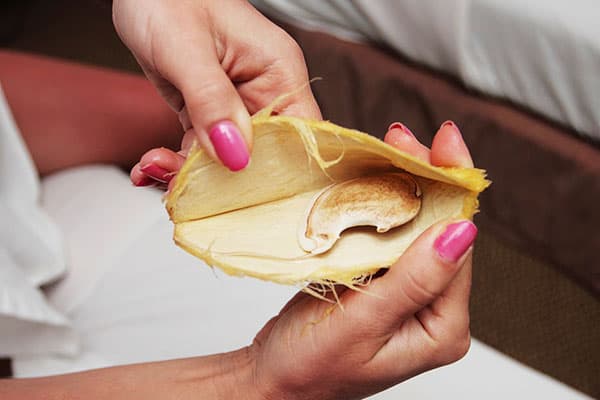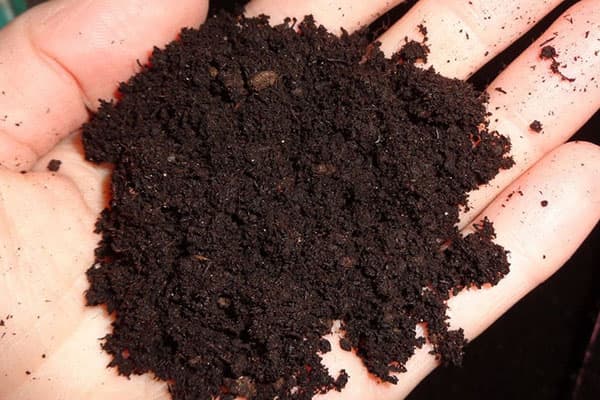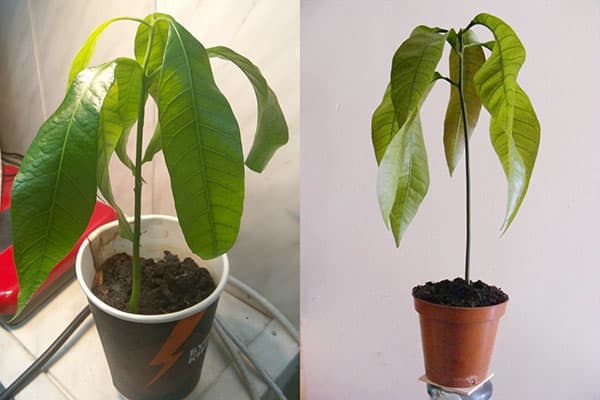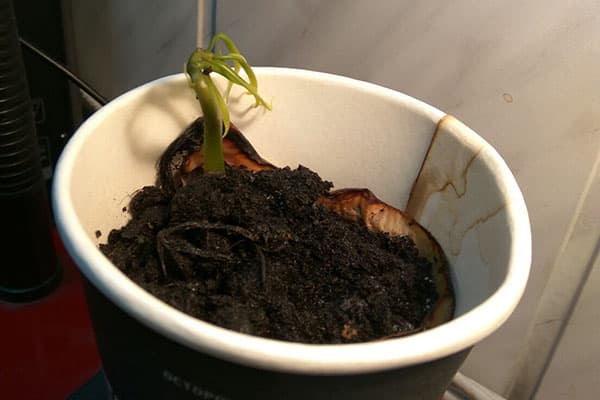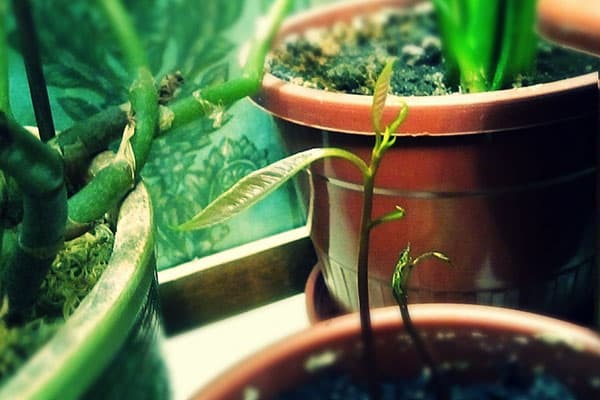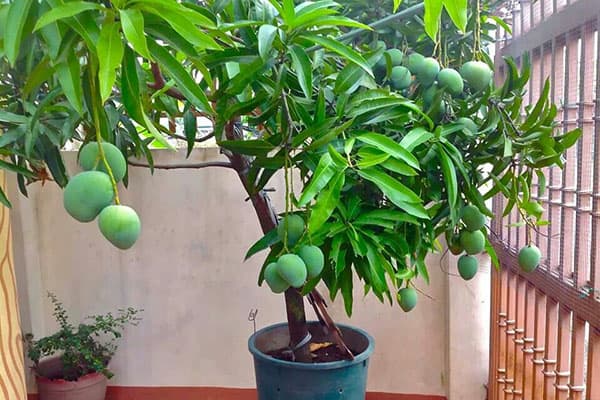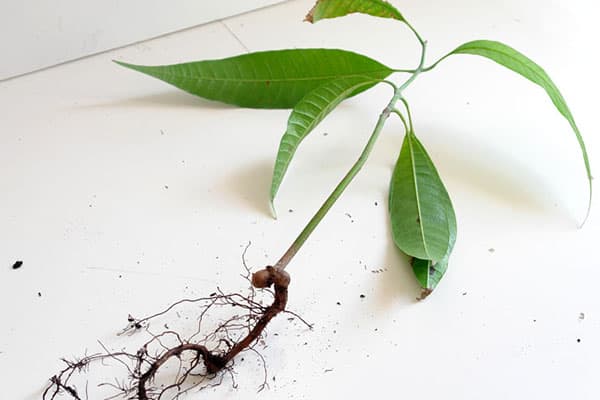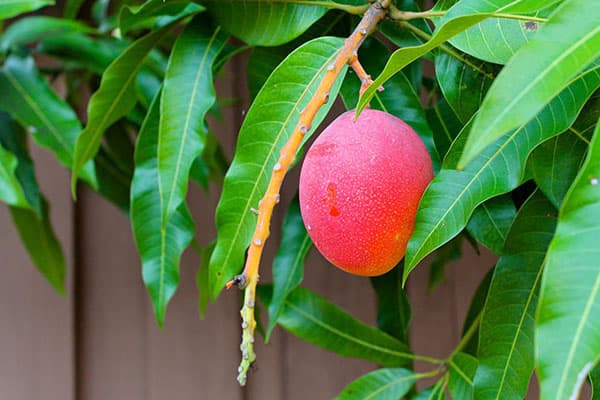How to plant a mango seed and grow a tree at home?
Content:
Ripe mangoes can be seen on store shelves, but the tree on which they grow is found only in countries with a tropical climate. The territory from Pakistan to Indonesia is considered to be the birthplace, but even in the northern latitudes it will not be difficult to grow mangoes from a seed if you learn all the secrets of planting this exot at home.
Where and how does a mango tree grow?
The mango tree belongs to the evergreen and never drops leaves. In the wild, its height can reach 45 m, and the diameter of the crown can be 10 m. Such a plant can be grown not only in the greenhouse: there are dwarf mangoes on sale that are more convenient to care for. When growing a house, the height of the plant will be about 1.5 m.
The mango tree is decorated with large bright green lanceolate leaves. Their length reaches 40 cm. Externally, the tree resembles a ficus.
If you get a grafted seedling, the tree will grow low, with a developed formed crown. If you grow mangoes yourself, the variety will be unknown and with a high probability it will be necessary to form a rapidly growing crown. To do this, the plant is pruned 1-2 times a year, leaving 3-4 branches for further growth.
An ungrafted tree does not bear fruit. If the goal is to get ripe aromatic fruits, the tree needs to be planted. Fruits grown at home will be no less beautiful, tasty and fragrant than those brought from India, Malaysia or another country.
Mango is a long-lived tree. The age of some specimens reaches 300 years, and at the same time they continue to give edible fruits. In India, one of these trees produces about 16 thousand fruits per year.
In the tropics, mangoes most actively bear fruit at an altitude of 1000 m, but despite this, an exotic tree can be grown from seed at home. An instruction with a detailed description of the process will help in this.
Potted Mango Growing
To start growing a mango tree, it is enough to have a seed seed and a minimum set of garden supplies.
It is very difficult to find seeds on sale. Purchased seed may be overdried - in this case you do not have to wait for seedlings from it. A win-win option is to buy a ready-made seedling, but it is not so interesting how to grow mango from the seed of a ripe fruit.
Where to get a seed for germination?
To grow a mango tree you need a ripe fruit.
Ripe mango is distinguished by such signs:
- easy separation of the stalk from the fetus, characteristic aroma during a break;
- loose fit of ripe pulp to the bone;
- softness and juiciness.
After choosing the ripe fruit, you need to check the state of the seed. To do this, clean it from the pulp and check the tightness of the flaps. The following options are possible:
- The leaflets of the bone are ajar. This means that the fruit is fully ripe, the probability of successful germination is 70%. A seed in the shape of a bean must be pulled out of the shell; it must be the size of a ½ matchbox. In order to avoid damage to the seed by harmful microorganisms, it should be treated with a fungicidal protective agent (for example, “Topaz”, “Skor”).
- The flaps are closed. Then you can use a sharp object, such as a knife, and open the walnut flaps.If the fruit is ripe, there should not be any special difficulties, but still you should not trust the process to small children. The main thing is not to damage the "bean" inside.
- Shutters are very tightly compressed, and further actions can lead to damage to the seed. In this case, you need to germinate the bone: place in a glass with water for up to 2 weeks; change the water every other day. An alternative way is to place a stone between wetted layers of cotton. After some time, the flaps themselves will begin to open and a small sprout will appear.
If germination failed the first time, you need to try again and be more careful about the choice of the fetus. High-quality seedlings are obtained from fresh green beans.
After preparing the bone, it is time to proceed with its landing.
Seed planting
You can plant the seed in a plastic cup or pot, having previously prepared the soil that is most suitable for growing a mango tree.
Growing soil
It is necessary to plant a bone in universal neutral soil (pH value is about 7). This is the best environment for plant nutrition. In more acidic or more alkaline soil, mangoes will die. Alternatively, you can prepare a mixture of 2 parts peat and 1 part coarse sand.
The drainage layer will prevent the decay, reproduction of the fungus and pathogenic bacteria, leading to the death of the root system.
As drainage, you can use:
- expanded clay,
- clay shards,
- coarse sand
- pebbles
- broken red brick
- gravel,
- Styrofoam.
Orchid lovers know that pine bark can be used as a drainage layer, however, it creates an acidic environment and can destroy mango seedlings.
It should be stocked with drainage volume, allowing you to fill the pot at least ¼ height.
After backfilling, the topsoil is recommended to be decontaminated: prepare a solution of 3-5 crystals of potassium permanganate in 200 ml of water and sprinkle the soil in a pot.
Which pot to put the mango in?
The mango tree is large and has a powerful root system. In the future, it needs to be planted in a pot with a diameter of about 30 cm, however, for a seedling, you can take a smaller pot - about 15 cm.
You do not need to immediately purchase a large pot for a tree. It will be difficult to dry the soil. As a result, the soil may become acidic and the roots will die.
Using a plastic cup for germination, you will have to transplant the plant in a month. This can adversely affect the state of an unstable seedling. It will be correct to plan the first transplant no earlier than a year after germination, so it is better to immediately use a medium-sized pot.
Planting mango seed
The crucial moment is landing. If there is no sprout yet, the seed should be thrust sideways. In the presence of a small germ, the seed is placed horizontally.
It is important that ¼ part of the seed remains on the surface. It should be ensured that it is not accidentally sprinkled with earth. Then the landing site is abundantly watered with settled water at room temperature.
Further it is necessary:
- To create a “greenhouse effect” - cover the planted seed with cellophane, cling film or a plastic bottle with a cut bottom.
- Make a small hole in the improvised greenhouse for air to enter, otherwise the sprout may rot.
- Put the pot in a warm room. The windows should face the sunny side, but exposure to direct sunlight should be avoided.
- Regularly moisten the earth in a pot. Every 2-3 days will be enough. More frequent watering can lead to waterlogging of the soil.
- Ventilate the greenhouse by lifting the film (unscrewing the lid of the plastic bottle) every 2 days for 10-15 minutes.
- Wait until a strong sprout appears (there may be several). The time from planting a seed to the appearance of a sprout is 2-3 weeks.
- After a month, make holes of a larger diameter in the greenhouse. It is not worth it to sharply remove the coating, otherwise the difference in temperature and humidity will destroy the plant.
As soon as it becomes noticeable that the tree has begun to grow, the greenhouse can be removed.
First sprouts: how to care for a tree
Mangoes need a lot of light and heat. The tree will grow rapidly in size if you follow the rules of care.
- Lighting
You do not need to put mangoes under the scorching sun. It is enough to place the pot near the window in a brightly lit place. If in the winter season, when the light day decreases, the plant begins to turn yellow, drop leaves, it is recommended to install an artificial light source.
- Air temperature
An evergreen tree needs a temperature of about + 25˚C. Its decrease by more than 7 degrees below normal can lead to deterioration. If in a room with a tree the air temperature reaches + 18˚С, it is time to install heating devices.
At a temperature of + 15 ° C the tree “falls asleep”. Critical temperature is + 5˚С. The coolness is destructive for a young tree.
- Fertilizer
Fertilizers will provide nutrition to the plant. For mangoes, biohumus and nitrogen-containing fertilizers are suitable. You can purchase nutrient mixtures intended for palm trees, citrus fruits.
In summer, top dressing is done every 2 weeks by watering the plant with solutions of nitrate, ammonium sulfate. Organic fertilizers (infusions of manure, manure, plant leaves) are also good as top dressing.
If it is decided to use humus as fertilizer, it is necessary to make a small indentation along the edge of the pot, to fill in biofertilizer and to sprinkle with a mini-trench on the ground. Such feeding will provide the plant with active growth for a period of up to six months.
How often to water?
Wet tropics are an ideal climate for mango growth. To recreate the most approximate conditions, you must:
- Control the humidity in the room. Ideally, it should be at least 70%.
- Water the plant at least once every 3 days. In the summer, air dryness increases, so it is better to irrigate up to 1 time in 2 days.
- Spray the plant 1-2 times a day or wipe the leaves with a damp cloth. Spraying should be sharp and short-lived. With waterlogging of the leaves and the stem, the likelihood of the appearance of a fungus that can destroy the crown is high.
The main thing is not to forget about watering and maintain a sufficient level of humidity.
Crown formation
When the tree reaches 1.5 m in height, it is time to form a crown. Mango painlessly transfers the trim of the top and easily restores it.
You should remove branches that create unnecessary density. The central branch can be cut to the desired size.
If desired, you can give the plant the shape of a pyramid, a ball, a sprawling tree.
Places of cuts must be treated with garden var. You can buy the product in the store or prepare it yourself by mixing equal parts of paraffin, rosin and drying oils.
Transfer
For a painless transplant, proceed as follows:
- moisten the soil with plenty of pot;
- carefully remove the plant with an earthen lump;
- put in a larger pot;
- sprinkle with earth.
In order for the plant to take root, it is necessary to put it in a dark place for 3-5 days, and then bring it into the light.
Mango grafting
Exotic tree will be able to bear fruit after grafting. You can do it yourself:
- Find the kidney of the fruiting tree and cut it with a sharp knife (moreover, in addition to the kidney, it is necessary to grab a piece of bark and wood).
- On a homemade mango, make a cross-shaped incision at the bottom of the trunk and gently bend the edges of the bark.
- Plant a kidney in the place of cut.
- Wrap the trunk at the point of attachment of the kidney with electrical tape and leave until germination.
After the kidney has taken root, the mango will bear fruit. However, you have to wait.
When does a mango begin to bear fruit?
Tree flowers do not have a special aesthetic value, but lovers of exotic plants expect their appearance with great trepidation. Homemade mango begins to bloom and bear fruit only 6-10 years after vaccination.
From the moment of flowering to the appearance of the fruit, 3 months pass, but how pleasant it is to try such a long-awaited exotic fruit grown at home!
So, success in growing a mango tree at home is largely dependent on the microclimate. The less light and humidity, the lower the chances of success. However, many gardeners manage to achieve the goal - their apartments are decorated with exotic plants with a spreading dark green crown, and sometimes even with fragrant juicy fruits.
